Handy Guides for the Home Improver
Site Clearing
Forget the gloves, wheel barrow and shovelling it takes to clear a backyard that’s been growing out of control for years, it will take you all day to clear a quarter of what you had planned, and with many people only able to have a crack on a Saturday or Sunday, that seems like a pretty daunting task for many that know it’s going to have to happen one day!!! With our Dingo attached to the rippers and bucket you can quickly and more efficiently clean a whole backyard in no time. Clear old weeds and dry unusable top soil with one pass over! Easily remove concrete garden surrounds, load materials into the bucket and empty into a skip or pile out of the way so you can do what you really want to do make your yard look great again! While extreme caution must be taken when operating the Dingo on sloped yards and hazardous areas you will be amazed at where these machines will go!!! Part of the free onsite training your DIY DINGO HIRE representative will gladly go through the job and discuss any concerns you may have. All in all to site clear without the use of a Dingo Digger means you’re obviously doing it for the fitness!
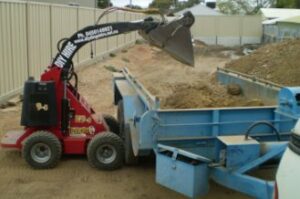

Lawn Preparation
For your new roll out or planted lawn to have the best chance of survival you really need to prepare the ground with a decent layer of loam. Any one that has just moved into a new home will know the ground that is left for you is definitely not suitable to roll out new lawn on. To get the ground to the required level and to fill a minimum 100mm recommended depth of loam with a wheelbarrow and shovel wouldn’t seem fun for anyone! All site clearing and levelling can be done simply and accurately with the Dingo. Once at your required level the Dingo will easily shift all your loam from where it’s usually dumped the front of the house to the back. The Dingo will then easily level and screed the loam all over the area for the new lawn in a fraction of the time you could do with hand tools, you might even be inside for lunch! Why pay a contractor to do something you could do yourself and have fun doing in the mean time!
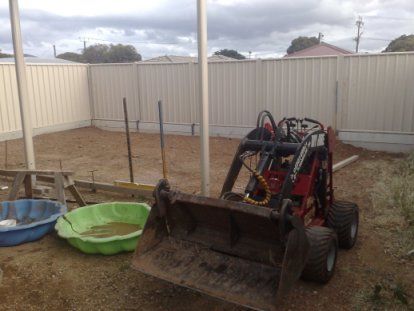
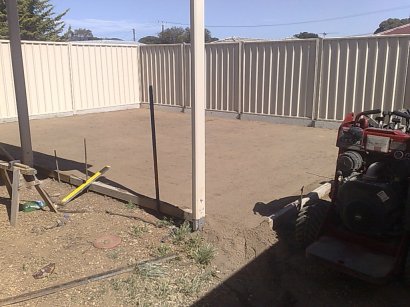
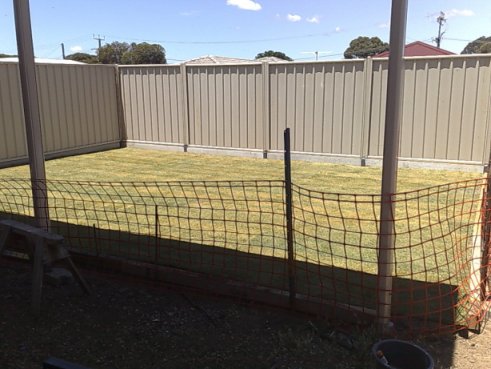
Fencing
With fencing like the Stratco good neighbour fencing and alike, fencing has never been more simple. The hardest part is digging the holes and while armed with a 2 man post hole digger you can still find digging into clay or hard soils very difficult, if you have used one before you know they’re not ideal! When the hire of a 2 man post hole digger is almost $150 per day from most hire companies why wouldn't you opt for a Dingo Digger! Attached with an auger drive and required size auger bit that can drill your post holes to the desired depth effortlessly with the power of a mobile hydraulic plant! With a large fencing job ahead doing it without the assistance of a Dingo digger makes you a glutton for punishment! With smaller jobs the added cost still may be economical because as the job will be done quicker you can use the Dingo in the same day for other jobs around the yard, even as simple as moving the pile of bricks you put in a spot you now regret!
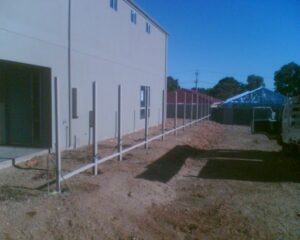
Retaining Wall
I know a lot of people would be thinking, no way I can’t do my own retaining walls! But in fact, in many situations, it’s not as difficult a job as you may first have thought. Although if the required retaining wall is over 1m in height a qualified contractor should be contacted as this shifts the goalposts considerably!
With the auger drive attachment, 450mm diameter drill bit and the Mini Diggers loading and lifting capabilities, doing your own retaining wall could never be easier!
See below the basic steps on how I’ve done it in the past, this is just how I’ve found it easy but there are plenty of other ways to get the job done.
- Firstly make sure you have your materials and tools ready, work out if you are going to order delivered pre-mixed concrete, dry pack bags or mix it yourself. (I always order pre-mixed, too lazy lol)
- Next make yourself up some timber spacers, pine stud will do and one for every bay is handy. I make mine 2020mm as the sleepers are always slightly bigger.
- Mark a line on either side of the steel post to where the underside of your bottom sleeper will sit allowing a little extra to fit, for an 800mm wall I would allow 810 or 815mm.
- The major difference with the method I use is I don’t support the post in the ground however I weld two small lengths of 12mm reo bar to the bottom of the post, this enables you to be less accurate with the hole depth,let’s you go deeper to put more concrete in and also ensures the bottom of the post won’t push out when the concrete is filled into the hole. If you don’t have a welder the steel place you buy the posts from could do it for you very easily. I’d leave 500mm out the bottom of the post you can always cut it shorter with and angle grinder if you need to.
- Set the height and line of either the inside or outside face of the posts is to be with a string line so you can measure for the required depth and line up/level the post.
- Spray paint the ground where the holes are to be dug.
- Dig your holes effortlessly with the dingo post hole driller. (Make sure you are aware of what may be in the ground, always “dial before you dig”)
- Once the holes are drilled you can drop the posts in, shimmy each one around with a level up against each edge moving the bottom of the post around until you get it right. It should be just touching the string-line on the face you set it up for and a couple of inches higher than it. Once satisfied that the post is level hit the top of the post down with a mallet / sledge hammer until it sits at the correct height set by the stringline, or a laser level if you’re that lucky!
- Place your timber spacer against the face of the beam and set up the next post until they’re all done.
- Pour concrete into the holes, adjusting the posts with the spirit level making sure they’re all in the correct location. Once all the concrete is in, continually go from post to post ensuring they haven’t moved, once the concrete is in the posts shouldn’t move as the pressure of the concrete and the reo bar in the ground will pretty much hold them up. Don’t pour the concrete higher than the mark you have made for the underside of the bottom sleeper, if the concrete is far lower just make a little pad for the sleeper edge to sit on.
- Once the concrete has gone off, usually the next day, simply slip the concrete sleepers in, don’t squash your fingers! You may need to cut the last bay if your wall length has to be exact, It may pay to know this measurement and have them pre-cut from where you buy your sleepers or order these last when the wall is up.
- If you need to you can now cover the back of the wall with a damp proof membrane, drop your agricultural drain in and use the dingo to backfill with crushed rock and fill.
It wasn’t that hard was it! You have just saved yourself thousands of dollars in one weekend!
Paving
Like the lawn preparation, similarly manually preparing for paving is an extremely arduous task!! From getting your yard to the required depth then filling with a rubble base you will spend days or have many more people assisting to get it done! With the Dingo digger on your side you will get the work done quickly and effortlessly! With blocks getting narrower and the work to be done usually right at the back of the block, the most convenient place to get the rubble or sand delivered is to the front driveway. Carting rubble or sand from one end of the block to the other can be a nightmare, with the Mini Digger doing all the lifting and carting it makes your work easy, freeing up other helpers to get things done other than shovelling the material into the continuous flow of wheelbarrows! Don’t forget you can also use the bucket to load up to 250kg of pavers to cart, and no one likes moving pavers by hand!
Landscaping
Landscaping your backyard can be a very rewarding process as you get to transform your yard into your own personal paradise. The problem is much of the work you have to do to get to paradise is hard backbreaking labour! Using the Dingo to take the majority of the backbreaking work out makes the job much more enjoyable again, having fun while you create your own space. When it comes to planting large trees, levelling ground, trenching for pipe work / electrical runs, laying mulch or even just moving materials around there is no easier way than using our Mini Diggers and saving extra weekends of work in the process! So when you want to transform your own yard but don’t feel like doing all the hard work give us a call and let one of our Mini Diggers help you out!
Storm Water
With the majority of builders leaving a newly built house without connected storm water pipes it’s an unpleasant task most new home owners will have to carry out. You can obviously get a contractor to come and do the work for you however as its more a labour intensive job rather than a skilful one on the most part (sorry plumbers) many opt to save some cash and give it a go themselves. I’ve had many customers try and have a crack with a pick and shovel first to quickly realize there isn’t many worse jobs to do than digging into ground by hand!! One of the most rewarding jobs to do on a Mini Digger is trenching for storm water pipes, this due to the instant results and quick job completion! Obviously this depends on the ground conditions and location of course!! On drop off we will run you though all controls and helpful hints needed to quickly get the worst part of the job done, digging the trenches! Once the trenches are dug, it’s simply a matter of laying your storm water pipes in the trench and cleaning / gluing each join with the correct materials that you can get from the hardware store when you buy your pipes. While it is always better to have a consistent fall even if its slight down to your outlet it is not always possible and it’s ok if it slightly falls away from the kerb as long as you have sealed the pipes well with the glue. The force of your water down the gutters will push the water out. Depending on the size and location of the house you should most likely have your whole house connected up in a day! I should mention I’m definitely far from being a plumber and this is simply general advice, for some houses with extreme falls professional advice might not be a bad idea, I am only supplying the trenching tool after all!! Saying that I’ve done my share of storm water and I know for a large percentage of new homes it’s a job you can easily do yourself and save a lot of money in the process!